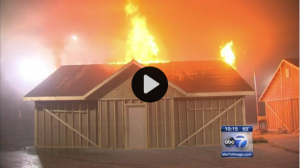On February 9, 2014, a Royal Air Force Voyager was transporting 189 passengers and a crew of 9 towards Afghanistan when the plane suddenly entered a steep dive. Many passengers were unrestrained and were injured by striking the ceiling or other objects. Other passengers were injured by flying objects or spills of hot liquid. More than 30 passengers and crew members reported injuries, all considered minor. The Military Aviation Authority’s final report contains details of the impacts from the dive, the causes of the dive, and recommendations that would reduce the possibility of a similar issue in the future.
 These impacts, the cause-and-effect relationships that led to them, and the recommended solutions can be captured within a Cause Map. The Cause Map process begins with filling in a Problem Outline, which captures the what, when and where of an incident, followed by the impacts to the goals. The problem covered by the report is the aircraft dive and resulting injuries which occurred on February 9, 2014 at about 1549 (3:49 PM) on an Airbus A330-243 Voyager tanker air transport flight. Things that were different, unusual or unique at the time of the incident are also captured. In this case, the plane had experienced prior turbulence, and the co-pilot was not in his seat at the time of the dive.
These impacts, the cause-and-effect relationships that led to them, and the recommended solutions can be captured within a Cause Map. The Cause Map process begins with filling in a Problem Outline, which captures the what, when and where of an incident, followed by the impacts to the goals. The problem covered by the report is the aircraft dive and resulting injuries which occurred on February 9, 2014 at about 1549 (3:49 PM) on an Airbus A330-243 Voyager tanker air transport flight. Things that were different, unusual or unique at the time of the incident are also captured. In this case, the plane had experienced prior turbulence, and the co-pilot was not in his seat at the time of the dive.
The next step is to capture the impacts to the goals on the Outline. In this case, the safety goal is impacted because of a significant potential for fatalities, as well as the more than 30 actual injuries. Customer service is impacted due to the steep dive of the plane, and the regulatory goal is impacted due to the court-martial of the pilot, as well as 10 lawsuits against the Ministry of Defense. Production was impacted because the plane was grounded for 12 days, the property goal is impacted because of the potential for the loss of the whole plane, and the labor goal is impacted by the investigation.
Beginning with an impact to the goal, all the cause-and-effect relationships that led to that goal are captured on the Cause Map. In this case, the potential for fatalities resulted from the potential loss of the plane. According to Air Marshal Richard Garwood, previous director general of the UK’s Military Aviation Authority (MAA), “On this occasion, the A330 automatic self-protection systems likely prevented a disaster of significant scale. The loss of the aircraft was not an unrealistic possibility.” The potential for the loss of the plane resulted from the steep dive. The reason the plane was NOT lost (and this becomes a significant near miss) is the plane was recovered to level flight by the flight envelop protection system, which functioned as designed. (Although this is a positive, not a negative, it’s a cause all the same and should be included in the Cause Map.)
The steep dive resulted from the controller being forced forward without being counteracted. These are two separate causes that resulted in the effect, and are listed vertically and joined with an “AND” on the Cause Map. More detail should be provided about both causes. The command could not be counteracted because the co-pilot was not on the flight deck. He had been taking a break for several minutes before the incident. The investigation found that the controller was forced forward by a camera that was pushed against the controller. The camera had been placed between the seat and the controller, and then the seat was pushed towards (as is normal to occur during flight).
The investigation found that, despite concerns for about a year prior to this incident, loose personal articles were not prohibited on the flight deck. While there was a requirement to stow loose articles, it was not referenced in the operational manual and instead became one of thousands of paragraphs provided as background, resulting in a lack of awareness of controller interference from loose articles. The pilot was found to be using the camera while on the flight deck, likely due to boredom on the highly automated plane. (Analysis of the camera and flight recordings provided evidence.) The pilot was court-martialed for “negligently performing a duty, perjury and making a false record”, presumably at least partially due to the use of a personal camera while solo on the flight deck.
The report provided many recommendations as a result of the investigation, including increasing seat belt use by passengers and crew during rest periods, which would have reduced some of the injuries caused by unrestrained personnel striking the ceiling of the aircraft. Recommendations also included ensuring manufacturer’s safety advice is included in operational documents, promoting awareness of the danger of loose articles, and maximizing use of storage for loose articles, all of which aim to reduce the risk of loose articles contacting control equipment. An additional recommendation is to manage low in-flight pilot workload in an attempt to combat the boredom that can be experienced on long flights.
To view the Problem Outline, Cause Map, and recommendations, please click “Download PDF” above. Or click here to read the Military Aviation Authority’s report.










